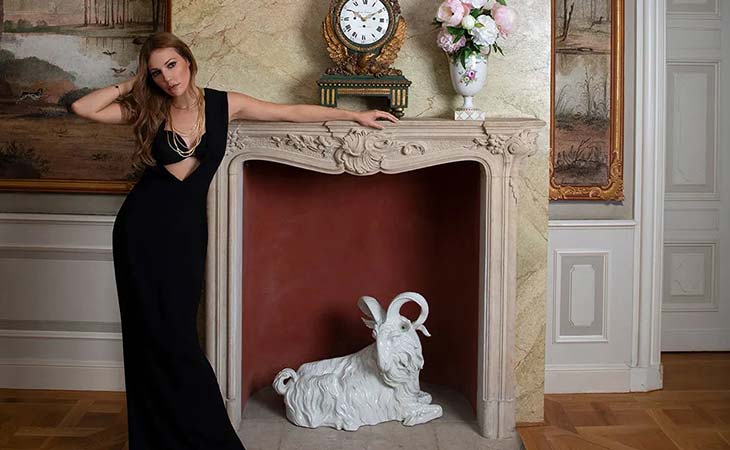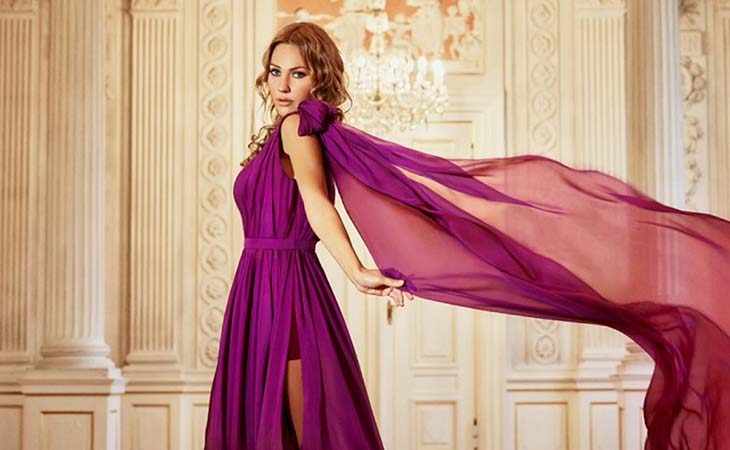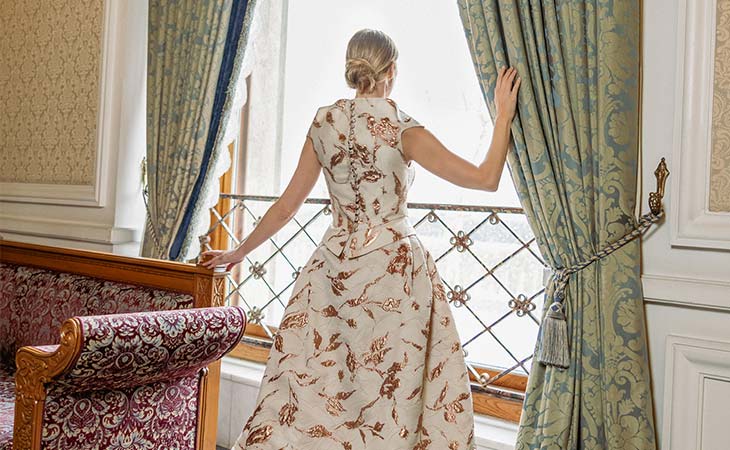The art of couture hand embroidery is one of the most important and influential aspects of the luxury fashion industry, playing a key role in creating the unique and luxurious feel of each garment beyond its artistic value. According to McKinsey & Company’s 2024 report, the global luxury fashion market has grown annually by 5.5% to over $330 billion, with the couture sector, as a symbol of creativity and refinement, holding a significant share in this growth. Delicate and artistic hand embroideries — including traditional French embroidery, Swarovski crystal embellishments, and precise pearlwork — are major distinguishing factors of couture garments, with many hours and considerable effort spent crafting each piece. These arts not only enhance the visual beauty but also add special structure and texture, transforming garments into unique works of art.
Table of Contents
- What is Couture Hand Embroidery?
- Traditional Embroidery Techniques in Couture
- Swarovski Crystal Embellishment: The Magic of Sparkle
- Hand Pearlwork and Detail Delicacy
- Tools and Materials Used in Couture Hand Embroidery
- Time, Cost, and Impact of Hand Embroidery on Final Garment Price
- Importance of Hand Embroidery in the Luxurious and Unique Feel of Garments
- Conclusion: Couture Hand Embroidery — A Bridge Between Tradition and Innovation
- Frequently Asked Questions
1.What is Couture Hand Embroidery?
Couture hand embroidery refers to a collection of decorative techniques executed manually with great delicacy on custom couture garments. This art blends traditional knowledge with modern innovations, turning luxury garments into unparalleled works of art. Each embroidery technique requires high skill and extreme precision, often taking several hours to several weeks to complete on a single garment.
Shine Bright at Night: Designing Evening Dresses with the Color of the Year 2025
2.Traditional Embroidery Techniques in Couture
Traditional embroidery in couture is one of the most intricate and delicate handcrafts, rooted deeply in the long history of fashion and still holds a special place in luxury, custom garments. These techniques are usually performed entirely by skilled artisans using silk threads, gold and silver threads, and sometimes pearls and small beads.
Key features of traditional embroidery techniques:
- Delicacy and intricate details: Patterns often include floral motifs, leaves, fine vines, and geometric designs created in several precise stages. These tiny details require concentration and skill to give the garment a soft yet textured appearance.
- Use of special threads: Silk and metallic threads (gold and silver) are favored for their shine and durability, reflecting light uniquely to give garments a bright, luxurious look.
- Varied stitching techniques: Chain stitch, herringbone stitch, couching, and French knots are among the stitches used, each creating different textures and visual effects. Combining these methods allows the artisan to craft diverse and attractive textures.
- Incorporation of pearls and beadwork: Sometimes, traditional embroidery is combined with pearl and bead embellishments to add volume and dimension, typically applied on collars, sleeves, or skirts, enhancing the 3D and luxurious feel.
- Lengthy execution time: Each piece may take hours to days, reflecting the precision, delicacy, and handmade nature of the work, making every couture piece unique and valuable.
- Preservation of tradition and knowledge transfer: Many of these techniques are performed in specialized workshops by master artisans who have passed their skills down through generations, making this heritage vital to the luxury fashion industry.
Conclusion:
Traditional embroidery techniques in couture symbolize skill, artistry, and patience, transforming luxury garments from mere products into works of art. These embroideries not only enhance the garment’s appearance but also carry stories of history, culture, and creativity in every thread and stitch.
Comprehensive Women’s Fashion and Style Guide
3.Swarovski Crystal Embellishment: The Magic of Sparkle
Swarovski crystal embellishment is one of the most popular methods for decorating couture garments, using small, sparkling crystals to add a luxurious and eye-catching effect. This technique requires precise skill in arranging and sewing the crystals so they shimmer under various lighting conditions, creating a unique visual impact.
Minimalist Style: A Fashion Staple That Never Goes Out of Fashion
4.Hand Pearlwork and Detail Delicacy
Hand pearlwork is a prominent couture technique involving sewing small and large pearls onto fabric, transforming the garment into a unique piece of art. This requires high precision to ensure the pearls are evenly and beautifully placed.
A Comprehensive Guide to Choosing the Perfect Evening Gown: Shine at Every Event!
5.Tools and Materials Used in Couture Hand Embroidery
Couture hand embroidery is a highly precise and delicate art requiring specialized and high-quality tools and materials. These tools and materials play a critical role in the final quality, delicacy, and durability of garment embellishments. Every professional atelier and expert designer uses a specific set of tools and materials to achieve the best results, described below:
Main Tools:
- Specialized hand needles: Needles of various sizes with very fine tips are used to pass precisely through delicate fabrics such as lace or silk without damaging them. Some needles are designed specifically for sewing pearls and crystals and are thicker and stronger.
- Small, sharp scissors: Embroidery scissors with very sharp edges are used for precise cutting of threads and small fabric parts, allowing great control over details.
- Embroidery hoop: This tool holds the fabric taut for more accurate and even stitching. Couture embroidery hoops are typically made of light, high-quality wood to avoid damaging the fabric.
- Tweezers and holding tools: Fine tweezers are used for placing small pearls, crystals, and other delicate decorations precisely.
- Light table and magnifying glass: Used in delicate stitching stages to better see small and complex details and to ensure precise embroidery.
Materials:
- Silk and metallic threads: Natural silk threads are the base of couture embroidery due to their softness and shine. Metallic threads in gold and silver are also used to add luxurious and prominent effects.
- Handmade pearls: Small, delicate pearls produced by hand provide garments with a unique, three-dimensional effect. Their quality is crucial for stable shine and color.
- Swarovski crystals: A favorite material in crystal embellishment, known for their precise cut and exceptional sparkle. These crystals come in various sizes and colors to create different effects.
- Beads and decorative stones: Various beads, semi-precious stones, and luxury buttons are used to enhance the garment’s decorative details.
- Delicate base fabrics: Fabrics such as fine lace, guipure, silk, and satin serve as the primary embroidery canvases and must be of high quality and structural stability to withstand hand embroidery.
Importance of Quality:
High-quality tools and materials not only enable better, more precise stitching but also protect delicate fabrics and increase the durability of decorations. In couture, every small detail matters, and using cheap materials or substandard tools can severely reduce final quality and damage the atelier’s reputation.
Conclusion:
Tools and materials for couture hand embroidery are the beating heart of creating artistic and luxurious garments. These specialized tools and quality materials allow artisans and tailors to execute very fine and complex details precisely, providing a unique and luxurious experience for clients. For professional ateliers like “Novag,” attention to these technical details is a fundamental investment in quality and brand prestige.
Secrets of Looking Good: Choosing the Right Clothes and Accessories for Every Body Type
6.Time, Cost, and Impact of Hand Embroidery on Final Garment Price
Couture hand embroideries are usually time-consuming and costly due to the need for highly skilled labor and many hours of meticulous work. These costs directly affect the final garment price and are one of the main reasons couture garments are expensive.
What Shoes to Wear with an Evening Gown?
7.Importance of Hand Embroidery in the Luxurious and Unique Feel of Garments
Couture hand embroidery gives garments identity and value, making each piece appear unique and special. These embellishments not only enhance visual beauty but also create a sense of luxury and exclusivity in the eyes of the customer.
Check out our store today and pick out your favorite outfit!
8.Conclusion:
Couture hand embroidery symbolizes the fusion of creativity, skill, and art that transforms luxury garments into timeless works. The use of traditional techniques like French embroidery, alongside modern methods of crystal embellishment and pearlwork, allows designers to showcase their creativity in garments with high quality and exquisite delicacy. These arts, besides their beauty and quality, have a significant impact on the price and final value of garments and are critically important for professional ateliers such as “Novag.”
9.Frequently Asked Questions
- What techniques are included in couture hand embroidery?
Couture hand embroidery includes various techniques such as traditional French embroidery, Swarovski crystal embellishment, hand pearlwork, and beadwork. These techniques are executed with very high delicacy and entirely by hand to give garments a unique and luxurious appearance. - What tools are used for embroidery and crystal embellishment?
The main tools include fine, specialized hand needles, small scissors, embroidery hoops, precise tweezers for placing small decorations, light tables, and magnifying glasses for delicate stitching. These tools help artisans perform decorations accurately without damaging sensitive fabrics. - Why is couture hand embroidery more expensive than ready-to-wear garments?
Couture hand embroidery costs more due to the need for very high skill, long hours of work, use of luxurious materials, and specialized tools. Each couture garment is a unique artwork made to measure, and these factors increase its final price. - How does hand embroidery increase the value and luxurious feel of garments?
Hand embroidery creates detailed, delicate, and three-dimensional embellishments that give garments a special, opulent, and unique appearance. The use of luxurious materials such as handmade pearls and Swarovski crystals adds extra sparkle and beauty, significantly enhancing the garment’s luxury and value.



